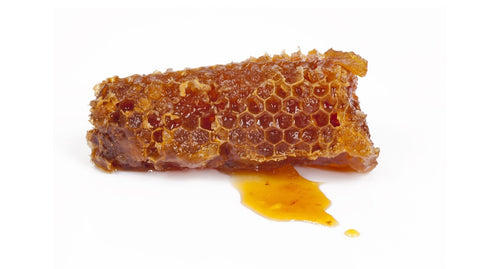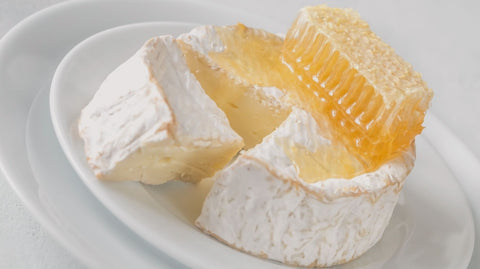Golden, glistening, and straight from the hive, honeycomb isn’t just beautiful, it’s a delicious and all-natural way to enjoy honey in its purest form. Made up of hexagonal wax cells filled with raw, unfiltered honey, honeycomb offers a unique texture and flavor experience that goes beyond what you'll find in a typical jar.
Whether spread on toast, paired with cheese, or eaten by the spoonful, this sweet, chewy treat has been enjoyed for centuries by honey lovers and curious foodies alike.
But honeycomb isn’t just about taste, it also comes packed with natural benefits. From the enzymes and antioxidants found in raw honey to the chewable beeswax that can support oral health, honeycomb is both a wholesome and indulgent addition to your diet.
In this post, we’ll walk you through exactly how to eat honeycomb and explore the reasons why adding it to your pantry might just be one of the sweetest decisions you make.
What Is Honeycomb?
Honeycomb is a natural structure made by honeybees to store honey, pollen, and their developing larvae. It's composed of perfectly shaped hexagonal cells crafted entirely from beeswax, a substance the bees produce themselves.
Inside these waxy cells, the bees store raw honey, a thick, golden liquid made from flower nectar and packed with nutrients. When harvested for consumption, honeycomb offers both the sweet, floral taste of raw honey and the chewy, edible texture of beeswax.
Unlike processed honey that’s often filtered and pasteurized, honey straight from the comb retains all of its natural enzymes, pollen, and antioxidants. It’s unrefined, unheated, and untouched by machines, making it a favorite among those who seek whole, raw foods. Eating honeycomb allows you to enjoy honey in its most authentic form, just as the bees intended.
Is It Safe to Eat Honeycomb?
Yes, honeycomb is completely safe to eat - and it's been enjoyed for thousands of years in cultures around the world. The honey inside the comb is raw and unprocessed, meaning it retains its natural enzymes, antioxidants, and nutrients.
The wax cells themselves are edible too; while they aren't digestible in the same way as the honey, they can be safely chewed and swallowed or spit out like gum.
As with any natural product, it's important to source honeycomb from a trusted supplier. Look for food-grade, raw honeycomb that hasn’t been treated with chemicals or exposed to high heat. People with severe allergies to pollen or bee products should consult with a healthcare provider before trying honeycomb, but for most people, it's a safe, wholesome, and delicious treat.
How to Eat Honeycomb: Simple Ways to Enjoy It
Honeycomb is not only delicious but incredibly easy to incorporate into your everyday meals and snacks. You can enjoy it straight from the comb, where the honey melts in your mouth and the wax offers a chewy texture.
Honeycomb is also a beautiful addition to both sweet and savory dishes, adding natural sweetness and a touch of rustic charm. Whether you're indulging solo or entertaining guests, honeycomb makes any meal feel a little more special.
Simple and Tasty Ways to Eat Honeycomb:
- Eat it by the spoonful right out of the comb.
- Spread it on warm toast, English muffins, or biscuits.
- Pair it with cheeses like brie, goat cheese, or blue cheese on a charcuterie board.
- Crumble over Greek yogurt, oatmeal, or smoothie bowls.
- Add to fresh fruit or green salads for a sweet contrast.
- Top desserts like cakes, tarts, or ice cream.
- Stir into warm tea or drizzle into herbal infusions (note: wax will not dissolve).
- Mix into baked brie or use as a topping for crostini with prosciutto.
Health Benefits of Honeycomb
Honeycomb offers more than just a delicious taste, it also provides a variety of health benefits thanks to its raw, unprocessed nature.
The honey inside the comb is rich in antioxidants, enzymes, and antibacterial properties that can support immune health and aid digestion. Because it hasn't been filtered or heated, it retains more nutrients than most store-bought honey, including small amounts of vitamins, minerals, and phytonutrients.
The beeswax itself also plays a role in wellness. While it isn’t digested like other foods, chewing beeswax may help promote oral health by stimulating saliva production and gently cleaning teeth. Some studies suggest that compounds found in beeswax have anti-inflammatory and antimicrobial properties.
Additionally, honeycomb is a natural, unprocessed alternative to refined sugar, making it a wholesome option for satisfying your sweet tooth.
Health Benefits of Eating Honeycomb:
- Contains antioxidants that support immune function.
- Raw honey may help soothe sore throats and aid digestion.
- Beeswax may promote oral health through gentle cleansing.
- Naturally antibacterial and antimicrobial.
- A healthier, unprocessed alternative to refined sugar.
- May support seasonal allergy relief (local honeycomb only).
- Can help boost energy with natural sugars and trace nutrients.
Tips for Buying and Storing Honeycomb
When shopping for honeycomb, look for a reputable source, especially if you want consistent quality and flavor. A reliable company like Ames Farm is a great example, offering raw, food‑grade honeycomb harvested sustainably and free from additives.
Whether you're buying locally or ordering online, ensure the honeycomb is clearly labeled as raw and unfiltered, and packaged to preserve its natural components. Avoid overly processed or pasteurized products, as these lose many of the beneficial enzymes and antioxidants that make raw honeycomb so valuable.
Once you’ve brought home your honeycomb, proper storage helps maintain its flavor and texture. Keep it in a sealed container at cool room temperature, ideally between 60°F and 70°F, and away from direct sunlight. For long‑term storage (several months to a year), refrigerating is fine, but bring it back to room temperature before eating to let the wax soften.
If you're storing honeycomb in the fridge, use a tightly sealed container to prevent it from absorbing odors. With these simple steps, your honeycomb from reliable sources like Ames Farm will stay fresh, flavorful, and ready to enjoy.
Final Thoughts About Honeycomb
Honeycomb is more than just a sweet treat, it’s a natural, nutrient-rich food that connects you directly to the work of the bees. Whether you’re enjoying it on toast, pairing it with cheese, or simply savoring it by the spoonful, honeycomb offers a unique experience that blends flavor, texture, and health benefits in every bite. Its versatility makes it easy to incorporate into both everyday snacks and elegant entertaining spreads.
By choosing high-quality honeycomb from trusted sources like Ames Farm and storing it properly, you can enjoy this golden delicacy for months to come. From supporting sustainable beekeeping to boosting your wellness routine, there are plenty of reasons to give honeycomb a try. So go ahead! Explore, taste, and see why this raw, unfiltered treasure has been beloved for generations.
FAQs About Honeycomb
Is honeycomb safe to eat?
Yes, honeycomb is completely safe to eat. The honey inside is raw and unprocessed, which means it retains its natural enzymes, antioxidants, and nutrients. The beeswax that forms the comb is edible too, although it isn't fully digestible, it's safe to chew and swallow or spit out like gum. For the best experience, buy honeycomb from trusted sources that offer food-grade, chemical-free products.
How do you eat honeycomb?
You can eat honeycomb straight from the comb by cutting a small piece and chewing it like candy. It can also be spread on toast, paired with cheese, crumbled into yogurt or oatmeal, added to salads, or used as a topping for desserts. Some people even let it melt in warm tea (though the wax won’t dissolve). It’s a versatile treat that adds texture and natural sweetness to many dishes.
Does honeycomb need to be refrigerated?
Honeycomb doesn’t require refrigeration, but it should be stored properly. Keep it in a sealed container at room temperature (ideally 60–70°F) and away from sunlight or heat. If you prefer, you can refrigerate it to extend its shelf life, but be sure to bring it back to room temperature before eating to soften the wax and enhance the flavor.
What are the health benefits of eating honeycomb?
Honeycomb offers several health benefits. The raw honey is rich in antioxidants, antibacterial compounds, and trace vitamins that support immune health and digestion. Chewing the beeswax can promote oral health by stimulating saliva and gently cleaning teeth. Plus, honeycomb is a natural alternative to refined sugar, offering sweetness with added nutritional value. Choosing local honeycomb may even help reduce seasonal allergy symptoms due to exposure to local pollen.


